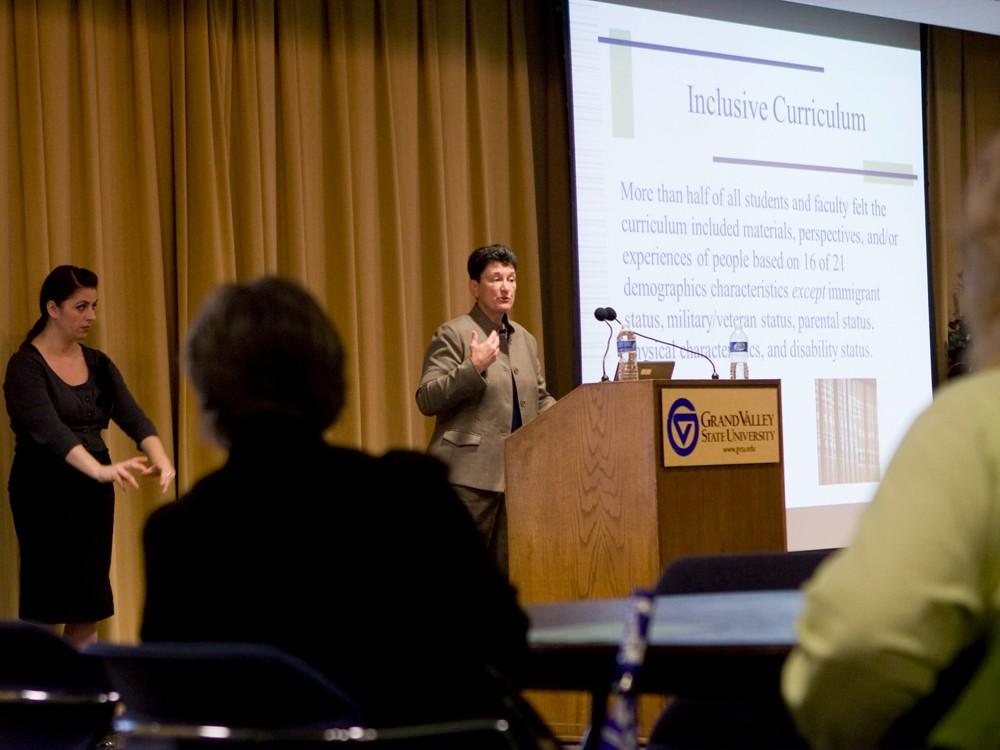Climate study results presented

GVL / Kate Kaurich Campus Climate Survey Results Speaker Sue Rankin
Oct 3, 2011
Sue Rankin, a senior research associate at the Center for Higher Education, visited both of Grand Valley State University’s campuses on Thursday and Friday to deliver the results of the myGVSU campus climate survey to the GVSU community. The myGVSU survey, conducted earlier this year, is the university’s fourth campus climate study and is designed to explore what it is like to live, learn and work at GVSU.
“Climate is very amorphous,” Rankin said. “It changes on a daily basis. We find that climate has an increasing impact on student learning and student development… We need to think about climate as a variety of things, not just diversity or equity.”
Overall, 7,571 individuals responded to the survey, and 6,110 respondents contributed comments to one or more of the survey’s open-ended questions. Approximately 29 percent of the GVSU community, including students, faculty and staff, participated in the climate survey.
Following the presentation of the survey results, GVSU will form a sub-committee of the Inclusion and Equity Advisory Board to determine the best courses of community action and how to address some of the issues highlighted in Rankin’s report.
“We are going to look for those action items; short-term things we can do,” Vice President of Inclusion and Equity Jeanne Arnold said. “We probably have enough data to look at for the next several years.”
Rankin said many unique statistics stood out while surveying GVSU. For instance, GVSU has one of the highest rates of LGBT students she has seen reported at any campus surveyed by her consultant firm, Rankin and Associates. But out of the total respondents, Rankin said LGBT people and persons of color were the least comfortable and least satisfied at GVSU overall, with “significant” differences between satisfaction rates of whites and people of color. In addition, she noted that many black students felt they do not have enough role models on campus.
The LGBT population and people of color were also reportedly the most common victims of harassment. Eleven percent of all respondents, or around 830 people, said they had experienced harassments, with most identifying it as “subtle,” such as receiving rude looks or feeling isolated from others. Students who reported observing harassment said it was most commonly derogatory remarks about another student’s sexual orientation or religion. Rankin said that GVSU’s harassment rate is comparably lower than other universities surveyed, where the typical reported harassment rate is 20 to 25 percent.
“It doesn’t mean it’s not important,” Rankin said. “Those little things that happen over and over and over again, it’s one little thing and then they blow. So you’re wondering, ‘Why is this person so mad? Why are they so upset about one little thing?’ But it’s not one little thing.”
One harassment statistic that is unique to GVSU, however, is who is allegedly perpetrating the harassment. Rankin said, typically, university harassment takes place between “co-horts,” such as student-on-student or staff-on-staff. But the most common form of harassment at GVSU is reportedly faculty-on-student harassment, a statistic that surprised Rankin.
“That’s the only time I’ve seen that in all of my work,” she said.
Also of concern to Rankin was the number of sexual assaults occurring at GVSU, which she said, while comparable to the percentage of sexual assaults from other campuses surveyed, still displayed some disturbing trends. One-hundred and fifty-four students, most commonly undergraduate women, said they were victims of sexual assault while at GVSU. Most of the incidents occurred in the first six weeks of the student’s freshman year. The majority of offenders were other students known to the victim. Eighty-eight percent of victims said they told a friend about the sexual assault, but many did not report the sexual assault to police or a counselor.
“The most common response was, ‘I didn’t report it because I was drinking too’ or ‘I didn’t report it because he was my friend and I didn’t want him to get in trouble,” Rankin said. “So that’s very serious… We have a rape culture at college campuses. This is not unique to GVSU.”
Rankin said some of GVSU’s key future challenges will be defining academic success and addressing racial tensions, homophobia, heterosexism and gender disparities.
However, the survey also revealed some encouraging statistics. Rankin said the GVSU community is a deceptively diverse one.
“You’re a primarily white institution, but you have a number of people identifying themselves outside of the choices you give them on the application,” she said. “But that’s a good thing. You’re a very diverse campus, despite the fact that you think you’re all white.”
In addition, 88 percent of students and 90 percent of faculty said GVSU is committed to inclusion and diversity.
Sixty-eight percent of students said GVSU employees were genuinely concerned about their welfare. 88 percent of respondents said they felt the campus climate was welcoming, 76 percent felt comfortable in GVSU’s workplace environment and 86 percent felt comfortable in the classroom.
The survey also revealed a few amusing statistics.
“I will tell you that one of the students reported they have been here for 20 years,” Rankin said. “So we need to try and get that student graduated.”
Additionally, 669 respondents identified themselves as being asexual, meaning they experience no sexual attraction to either gender. According to a study by The Journal of Sex Research, only about one percent of the adult population is asexual. Rankin attributed this unusually high number of allegedly asexual students at GVSU to students wrongly believing asexuality means they are celibate or abstinent.
An executive summary of the survey results is available for public viewing at www.gvsu.edu/mygvsu.

























